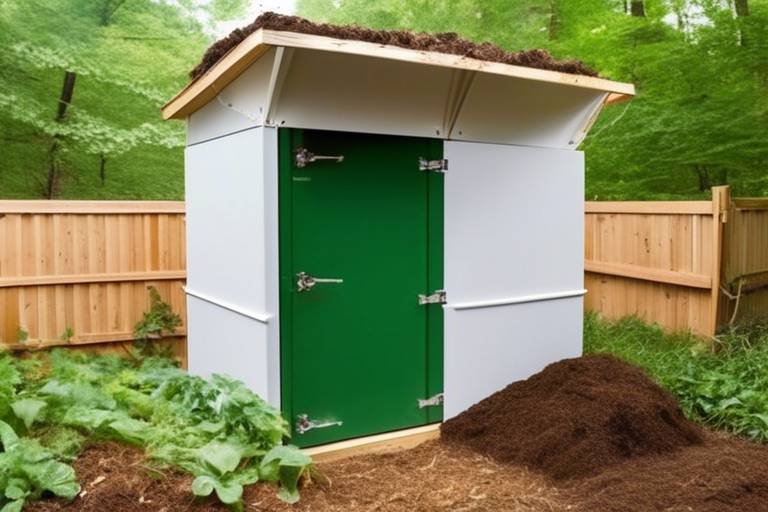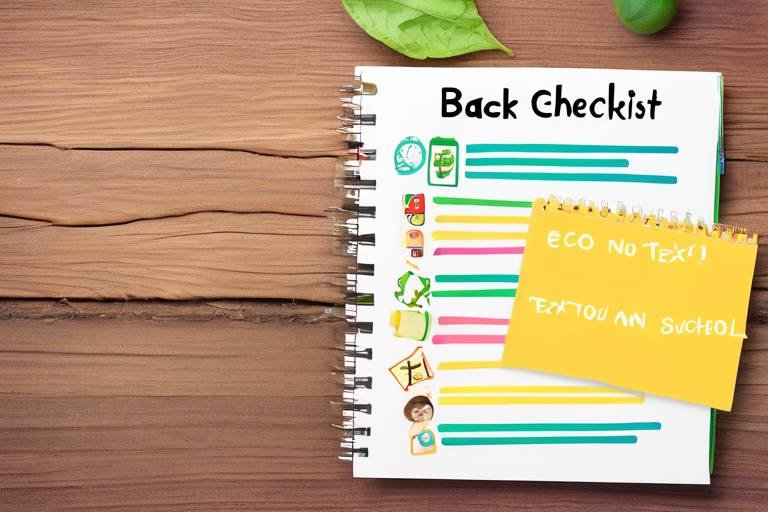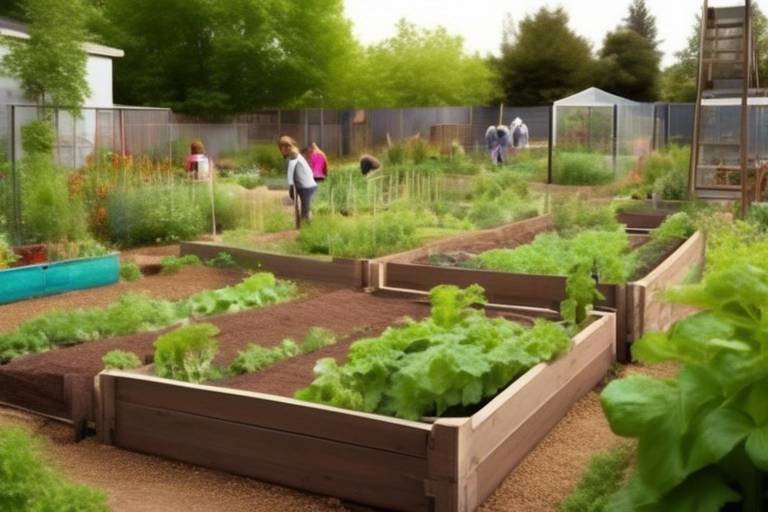How to Create a Sustainable Meal Plan
Creating a sustainable meal plan involves more than just deciding what to eat each day; it requires thoughtful consideration of the environmental impact of our food choices. By incorporating sustainable practices into our meal planning, we can not only improve our health but also contribute to a healthier planet. Let's explore some tips and strategies for developing a meal plan that is both nutritious and eco-friendly.

Evaluating Your Current Eating Habits
Tips and strategies for developing a meal plan that is not only healthy but also environmentally friendly and sustainable for long-term health and wellness.
Assessing your current diet is the first step towards creating a sustainable meal plan. Take a close look at what you eat on a daily basis. Are you consuming a balanced diet with a variety of nutrients? Are there any areas where you can make improvements to promote sustainability and better health?
Meal prepping and planning play a crucial role in sustainability, time management, and reducing food waste. By preparing meals in advance, you can ensure that you have healthy options readily available, reducing the temptation to opt for less sustainable choices.
When planning your meals, prioritize seasonal and locally sourced ingredients. Not only does this support local farmers and businesses, but it also reduces the carbon footprint associated with transporting food long distances. Seasonal produce is often fresher, tastier, and more nutrient-dense.
Integrating plant-based proteins and sustainable protein sources into your meal plan can have significant health and environmental benefits. Consider incorporating legumes, nuts, seeds, and tofu as alternatives to meat. These options are not only nutritious but also have a lower environmental impact.
Minimizing food waste is essential for a sustainable meal plan. Proper storage techniques, meal prepping strategies, and creative ingredient use can all help reduce the amount of food that ends up in the trash. By being mindful of portion sizes and utilizing leftovers effectively, you can cut down on waste.
Implementing composting practices and recycling efforts can further reduce the environmental impact of food waste. Composting organic matter creates nutrient-rich soil for gardening, closing the loop on food waste and promoting sustainability.
When planning your meals and grocery shopping, aim to make budget-conscious and environmentally sustainable choices. Look for sales on seasonal produce, buy in bulk to reduce packaging waste, and consider purchasing items with minimal packaging to minimize waste.
Consider starting a home garden to grow your own produce. This not only ensures a fresh and sustainable supply of fruits and vegetables but also connects you with the process of food production. Gardening can be a rewarding and educational experience that contributes to a more sustainable meal plan.

Meal Prepping and Planning
Meal prepping and planning is a crucial aspect of creating a sustainable meal plan that promotes both health and environmental well-being. By dedicating time to prepare meals in advance, you can not only save time during busy weekdays but also reduce food waste significantly. Imagine having a fridge stocked with pre-made meals that are not only nutritious but also contribute to a healthier planet. It's like having a personal chef that aligns with your sustainability goals!
One effective strategy for meal prepping and planning is to create a weekly menu that includes a variety of dishes using seasonal and local ingredients. This not only ensures freshness and flavor but also supports local farmers and reduces the carbon footprint associated with food transportation. Additionally, incorporating plant-based proteins and sustainable protein sources into your meal plan can further enhance its environmental impact while providing essential nutrients for your body.
When it comes to meal prepping, organization is key. Consider investing in reusable storage containers to portion out meals for the week ahead. This not only streamlines the process but also helps in portion control, preventing overeating and food waste. By planning your meals in advance, you can also make strategic grocery shopping decisions, avoiding impulse purchases and sticking to a budget-friendly and sustainable shopping list.
Furthermore, meal prepping allows you to get creative with leftovers and unused ingredients. Instead of throwing away food scraps, consider incorporating them into soups, stews, or salads. This not only reduces waste but also adds depth and flavor to your meals. Implementing composting practices for food scraps that cannot be consumed is another sustainable way to minimize your environmental impact.
Overall, meal prepping and planning is a holistic approach to creating a sustainable meal plan that benefits both your health and the planet. By being mindful of your food choices, reducing waste, and incorporating sustainable practices into your meal preparation routine, you can enjoy delicious meals while contributing to a more sustainable future.

Choosing Seasonal and Local Ingredients
When it comes to creating a sustainable meal plan, one of the key factors to consider is choosing seasonal and local ingredients. By selecting ingredients that are in season and sourced from local producers, you not only support the local economy but also reduce the carbon footprint associated with transporting food long distances.
Seasonal ingredients are typically fresher, tastier, and more nutritious as they are picked at their peak ripeness. Incorporating seasonal fruits and vegetables into your meal plan can add variety and flavor while ensuring that you are consuming produce at its best. Additionally, seasonal ingredients are often more affordable due to their abundance during specific times of the year.
Local ingredients play a crucial role in sustainable meal planning by promoting community connections and reducing the environmental impact of food production. By purchasing from local farmers and markets, you can trace the origin of your food, support sustainable farming practices, and reduce the use of pesticides and chemicals that are often associated with large-scale agriculture.
When choosing seasonal and local ingredients, consider exploring farmer's markets, community-supported agriculture (CSA) programs, and local grocery stores that prioritize sourcing from nearby producers. By building relationships with local farmers and suppliers, you can gain a deeper understanding of where your food comes from and make informed choices that align with your sustainability goals.
Remember, the journey of creating a sustainable meal plan begins with conscious choices about the ingredients you use. By prioritizing seasonal and local options, you can not only enhance the flavor and quality of your meals but also contribute to a healthier planet and community.

Plant-Based and Protein Alternatives
When it comes to creating a sustainable meal plan, incorporating plant-based and protein alternatives is key to promoting both personal health and environmental well-being. By shifting towards a diet rich in plant-based proteins and sustainable protein sources, individuals can significantly reduce their carbon footprint while improving their overall health.
Plant-based alternatives such as legumes, nuts, seeds, and tofu offer a wealth of nutrients without the environmental impact associated with animal-based proteins. These options are not only rich in protein but also high in fiber, vitamins, and minerals, making them excellent choices for a balanced and sustainable meal plan.
Additionally, exploring alternative protein sources like quinoa, tempeh, and seitan can add variety to your meals while supporting sustainable food production practices. These sources of protein are often more resource-efficient and environmentally friendly compared to traditional animal proteins, making them a valuable addition to any sustainable meal plan.
By incorporating a variety of plant-based and sustainable protein alternatives into your diet, you can reduce your reliance on resource-intensive animal agriculture while promoting your own health and well-being. Making conscious choices about the protein sources you consume is a powerful way to contribute to a more sustainable food system for the benefit of both present and future generations.

Reducing Food Waste
Reducing food waste is a crucial aspect of creating a sustainable meal plan that benefits both your health and the environment. By implementing strategies to minimize food waste, you can not only save money but also contribute to a healthier planet. One effective way to reduce food waste is through proper storage techniques. Storing fruits and vegetables in the right conditions can help extend their shelf life and prevent them from spoiling prematurely. Additionally, utilizing meal prepping techniques can help you plan your meals in advance, ensuring that all ingredients are used efficiently and nothing goes to waste.
Another strategy to reduce food waste is to get creative with ingredient use. Instead of throwing away leftover vegetables or grains, consider incorporating them into new dishes or using them as toppings for salads or soups. This not only reduces waste but also adds variety to your meals. Composting is another effective way to minimize food waste. By composting food scraps and organic waste, you can create nutrient-rich soil for your garden, closing the loop on the food cycle and reducing the amount of waste that ends up in landfills.
When grocery shopping, consider buying only what you need and avoiding impulse purchases. Planning your meals in advance and creating a shopping list can help you stay focused and prevent buying excess food that may end up going to waste. Additionally, be mindful of expiration dates and try to use up perishable items before they spoil. By being conscious of your food consumption habits and taking proactive steps to reduce waste, you can play a part in creating a more sustainable food system for the future.

Composting and Recycling
Composting and recycling are essential practices in creating a sustainable meal plan that not only benefits your health but also contributes to environmental preservation. Composting involves the decomposition of organic waste materials, such as fruit and vegetable scraps, into nutrient-rich soil that can be used to nourish plants in your garden. By recycling food scraps through composting, you not only reduce the amount of waste sent to landfills but also create a valuable resource for sustainable gardening.
Recycling, on the other hand, involves the processing of materials like glass, plastic, and paper to create new products, reducing the need for raw materials and energy consumption. By incorporating recycling into your meal planning routine, you can minimize the environmental impact of packaging waste and contribute to a more sustainable future.
When it comes to composting, setting up a compost bin in your backyard or using a composting service can help you manage food scraps effectively. By separating organic waste from non-compostable materials, you can create a closed-loop system that transforms waste into a valuable resource for your garden.
Similarly, recycling food packaging materials like glass jars, cardboard boxes, and plastic containers can help reduce the amount of waste that ends up in landfills. By rinsing and sorting recyclable items properly, you can ensure that they are processed efficiently and used to create new products, closing the recycling loop and conserving valuable resources.
By embracing composting and recycling practices in your meal planning routine, you can not only reduce your environmental footprint but also promote a more sustainable lifestyle that benefits both you and the planet. Incorporating these practices into your daily routine can have a significant impact on the health of our planet and contribute to a more sustainable future for generations to come.

Budget-Friendly and Sustainable Choices
When it comes to creating a sustainable meal plan, making budget-friendly choices is key to long-term success. By being mindful of your spending habits and the environmental impact of your food choices, you can achieve a healthy and eco-friendly diet without breaking the bank.
One strategy for saving money while maintaining sustainability is to plan your meals around affordable and nutritious ingredients. Consider incorporating cost-effective staples like beans, lentils, whole grains, and seasonal vegetables into your meal rotation. These items are not only budget-friendly but also packed with essential nutrients.
Additionally, shopping in bulk can be a great way to save money and reduce packaging waste. Buying items like rice, pasta, nuts, and seeds in bulk quantities can lower the cost per serving and minimize the amount of plastic or paper packaging used.
Another cost-saving tip is to avoid pre-packaged and processed foods, which tend to be more expensive and produce more waste. Instead, opt for whole foods that can be bought in larger quantities and used in multiple recipes. This not only saves money but also reduces the environmental impact of excess packaging.
Furthermore, consider exploring local farmers' markets and co-ops for fresh, affordable produce. By supporting local growers, you can reduce the carbon footprint of your meals while enjoying seasonal fruits and vegetables at competitive prices.
Lastly, meal planning and preparation are essential for both budget-conscious and sustainable eating. By mapping out your meals for the week, you can avoid impulse purchases and make the most of ingredients you already have on hand. This not only saves money but also minimizes food waste, contributing to a more sustainable lifestyle.

Growing Your Own Food
Growing your own food can be a rewarding and sustainable practice that not only provides you with fresh produce but also reduces your carbon footprint. By cultivating your own fruits, vegetables, and herbs, you have greater control over the quality of your food and can ensure that it is free from harmful pesticides and chemicals. Additionally, growing your own food allows you to connect with nature, promote biodiversity, and support local ecosystems.
One of the key benefits of growing your own food is the ability to harvest produce at its peak ripeness, resulting in better flavor and nutritional content. When you pick fruits and vegetables straight from your garden, you can enjoy them at their freshest, maximizing their taste and health benefits. This direct farm-to-table approach eliminates the need for long-distance transportation and storage, reducing energy consumption and greenhouse gas emissions.
Furthermore, home gardening can be a cost-effective way to supplement your grocery shopping and save money in the long run. By investing time and effort into cultivating your own food, you can lower your overall food expenses and create a more sustainable food budget. Whether you have a spacious backyard or a small balcony, there are various methods, such as container gardening or vertical gardening, that can accommodate different living environments.
In addition to the economic and environmental advantages, growing your own food can also be a therapeutic and stress-relieving activity. Spending time outdoors, tending to your garden, and witnessing the growth and development of plants can have a positive impact on your mental well-being. Gardening has been shown to reduce stress, improve mood, and increase overall feelings of happiness and satisfaction.
Frequently Asked Questions
- What are the benefits of creating a sustainable meal plan?
A sustainable meal plan not only promotes long-term health and wellness but also reduces environmental impact by supporting local farmers, minimizing food waste, and conserving resources for future generations.
- How can I evaluate my current eating habits?
You can assess your diet by keeping a food journal, identifying areas where you can make healthier and more sustainable choices, and seeking guidance from nutrition professionals if needed.
- Why is choosing seasonal and local ingredients important?
Seasonal and local ingredients are fresher, more flavorful, and have a lower carbon footprint since they require less transportation. By supporting local farmers, you also contribute to the community's economy.
- What are some budget-friendly sustainable choices for meal planning?
You can save money and reduce waste by meal prepping, buying in bulk, opting for plant-based proteins, and growing your own produce. These choices not only benefit your wallet but also the environment.
- How can I effectively reduce food waste in my meal planning?
Minimize food waste by storing ingredients properly, using leftovers creatively in new dishes, and implementing composting and recycling practices. These strategies help conserve resources and protect the planet.



















